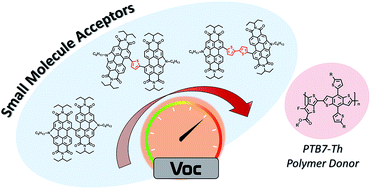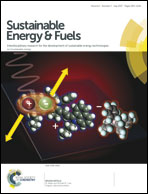N-annulated perylene diimide dimers: the effect of thiophene bridges on physical, electronic, optical, and photovoltaic properties†
Abstract
In this work, we report on the synthesis, characterization, and photovoltaic properties of two new N-annulated PDI derivatives connected with one (M1) or two (M2) thiophene bridging units and directly compare to a twisted PDI dimer with no thiophene units (tPDI-Hex). Compounds M1 and M2 were synthesized using an optimized direct heteroarylation carbon–carbon bond forming method. A combination of optical absorption and emission spectroscopy, cyclic voltammetry, polarized optical microscopy, X-ray diffraction, and density functional theory were used to characterize all compounds. Introduction of thiophene units into the PDI dimer scaffold served to red-shift the optical absorption and lower electron affinities. A decrease in the fluorescence intensity of M1 and M2 relative to tPDI-Hex was observed and attributed to photoinduced electron transfer. Notably, both M1 and M2 exhibited less structured thin-films as evidenced by optical microscopy and thin film X-ray diffraction. Photovoltaic properties were evaluated by fabricating bulk heterojunction solar cells with the inverted architecture ITO/ZnO/BHJ/MoOx/Ag and using PTB7-Th as the donor polymer. All solar cells were made and tested in air, and only ‘as-cast’ active layers were evaluated to ensure a direct comparison amongst the three acceptors. Solar cells with PTB7-Th:tPDI-Hex gave power conversion efficiencies of ∼5% with Vocs of 0.95 V, akin to our previous results. Comparatively, solar cells with PTB7-Th:M1 and PTB7-Th:M2 active layers exhibited higher Voc values upwards of 1.05 V but only had PCE of 1.1–1.2% when cast from chloroform, which we attributed to the formation of large domain sizes. A change in casting solvent to o-xylene resulted in improved bulk heterojunction morphology by reducing domain size and a doubling of the PCE values to ∼2% was realized for devices using M1 and M2 as electron acceptors. Use of the high boiling solvent, trimethylbenzene, resulted in further improvements in PCE for M1 and M2, increasing the PCE for devices using these acceptors to ∼3%. Importantly, devices made using the new materials exhibit low energy losses in the range of 0.5–0.7 eV.

- This article is part of the themed collection: CSC100: Celebrating Canadian Chemistry


 Please wait while we load your content...
Please wait while we load your content...